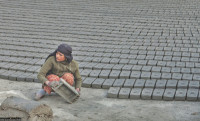Opinion
The government needs to manage land use
Laws should be created to control unscientific fragmentation for real estate purposes.
Santosh Pathak
Land is scarce, and the ongoing trends of urbanisation, fragmentation, and rapid infrastructural development continue to make it even scarcer. Nepal's constitution includes provisions for scientific land reform, discouragement of absentee land ownership, land pooling, and utilisation of land use policy for uplifting agricultural production. But the actual implementation of these provisions is barely visible. Only a small portion of the country's land area in the plains is fertile enough for agricultural production, the rest of the land consists of hills and mountains. Besides, urbanisation is growing in Nepal at a rate of 3.38 percent annually. Laying concrete structures on productive land without promising planning is emerging as a challenging issue, especially in the valleys and the Tarai.
Quite surprisingly, about half of the total population of the country is residing on the productive land of the Tarai. It seems that the hills and mountains are being abandoned and the plains are being filled up. If the government fails to make a timely intervention to check this trend, it will surely emerge as a major threat to our agricultural system, lifestyle and environment. One reason the government needs to immediately implement a strict land use policy is to substantially restrict the rate of farmland fragmentation and the ongoing unplanned construction activities on the fertile soil. In Nepal, the average farm holdings are only 0.65 hectares with four parcels per holding. With small plots of farmland, running efficient agricultural production activities is really challenging. Farmers can’t be forced to remain in the profession if they can’t make a living by farming.
Mass production
Furthermore, agricultural commercialisation will not be viable unless our farmlands are aggregated and planned for mass scale production. To do so, there is a need to amend the existing land inheritance system. People inherit land from their parents by making a one-time small tax payment. This is a major flaw in our system. The ownership and transfer of land should be based on how much tax a particular individual pays. This will prevent people from leaving their land fallow and also discourage absentee land ownership.
In addition, a tax-based system will benefit farmers who are in need of land to pursue farming on the scale they desire. Another advantage of this system is that the land will come under the ownership of the government so that the execution of plans regarding settlement and cultivation can be effective, which will be pivotal in turning the long cherished dream of agricultural transformation into reality. In the past, most people in Nepal lived on the hills and farmed the lands. This is not the case now. Many people have abandoned the hills and chosen to live on the plains to enjoy a life of ease. With the area of land being limited, there is no other feasible option other than dividing the existing plots of farmlands in the plains. Farmland fragmentation is equally responsible for the increased cost of inputs, reduced net income and weakened economic competitiveness of farmers.
In order to prevent this, there is an urgent need to create land use rules so as to control unscientific fragmentation for real estate purposes and haphazard building of houses. Setting a minimum plot size could deter fragmentation. Imposing higher taxes on those living on fertile plains and those involved in the real estate business would be effective in minimising uncontrolled transactions of land parcels. Otherwise, we may end up having cities like Kathmandu, which was once renowned for its fertility and agricultural production. To prevent this from happening in other areas, land pooling must be initiated in prospective towns and cities. The government should demarcate the areas for growing food, setting up industries and establishing settlements.
Timely intervention
Restricting land use does not mean forcing people to stay in the remote parts of the hills, but to encourage the people intending to migrate downwards to reside on the lesser slopes of foothills where basic infrastructures for a quality living can be assured without significantly higher investment in comparison to the plain areas. As development has just started taking pace in Nepal, and this is the right time for the government to intervene in land use. The topmost priority of the government has always been agriculture with its prospects outweighing all other sectors of the country. The reluctance of the people to pursue agriculture owing to a low rate of return with farms being operated on a non-optimal scale needs to be addressed. Otherwise, the vast swathes of farmlands will remain barren. Without timely intervention, these farmlands will diminish to a much smaller scale within a few generations.
The hill areas will remain abandoned if no schemes are launched to stop the people from moving completely downwards. The proposed intervention is meant to discourage people from occupying plain lands for construction and settlement purposes. The situation demands urgent attention and prompt action. There will be no moral ground to repent in the future without the will to deal with this serious problem at this moment when transcending to a state of rational use of land is still possible and attainable.
Pathak is a graduate student of agricultural economics at Louisiana State University, US




 7.12°C Kathmandu
7.12°C Kathmandu










